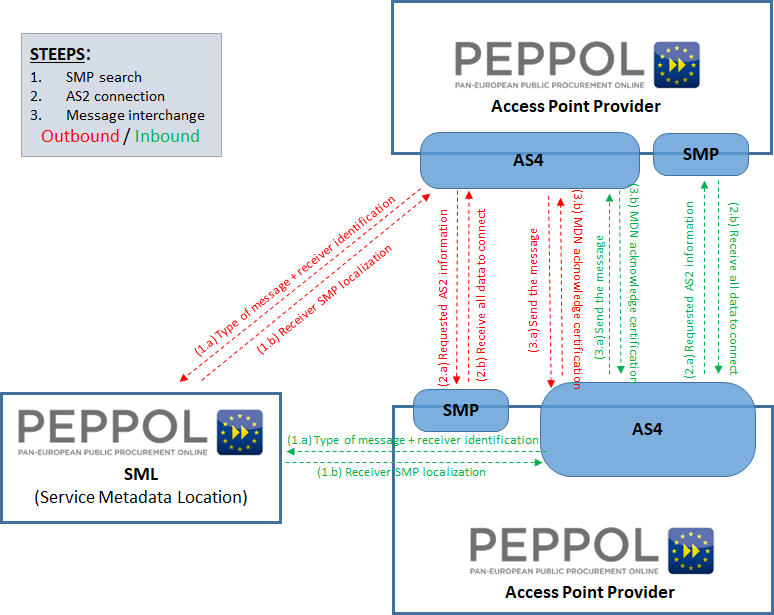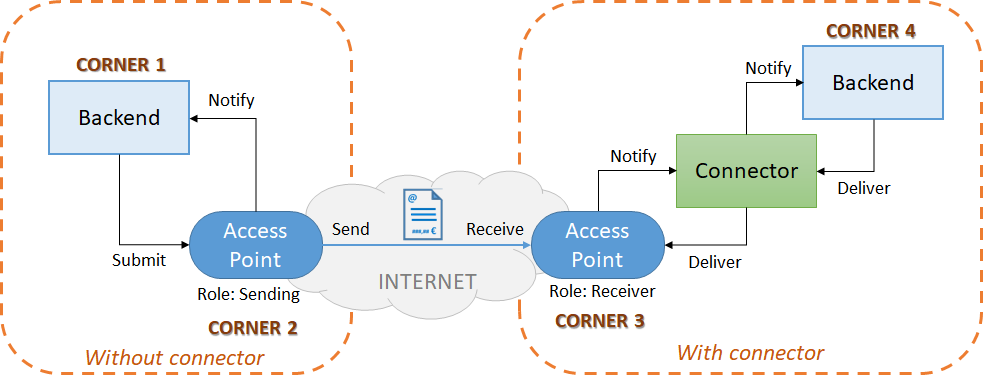OBJECTIVES OF THE ACTION
The main objectives of this EURINV19 project are:
- To upgrade the eInvoicing cloud platforms of 6 EDI providers of the consortium to become fully compliant with the EN, including UBL 2.1 and CII syntaxes. These implementations will achieve advanced eInvoicing functionalities to: (i) send/receive invoices compliant with the EN; (ii) translate invoices into different formats for the data integration in ERPs systems; (iii) real time reporting of invoices and cross-border transactions; and, (iv) guarantee interoperability with ERP systems.
- The uptake of eInvoicing solutions compliant with the EN by 4 participants the EURINV19 consortium.
The 6 cloud platforms updated under this Action are consolidated eInvoicing solutions supported by relevant EDI Providers from different Member States
These platforms will be upgraded in order to be fully compliant with the EN, including both syntaxes approved by CEN (UBL 2.1 and CII) and achieving advanced eInvoicing functionalities. These cloud platforms have their own certified PEPPOL Access Point fully aligned with the requirements set in the eIDAS Regulation, addressing eDelivery for cross-border communication.
These updates by the EDI providers to accomplish the EN will have a relevant impact across European digital borders since these enterprises have thousands of clients and operate in countries other than those where they are legally located. In turn, this implementation in these Member States will allow economic operators to be able to send eInvoices to central, regional, and local public authorities from other Member States.
Furthermore, the uptake of an eInvoicing solution compliant with the EN by 4 entities in other 3 Member States will fulfil with both objectives of the CEF-TC-2019-1 Call (update and uptake of eInvoicing solutions) and the EURINV19 consortium covers the whole cross-border scenario: invoice senders, invoice receivers and eInvoicing providers from different Member States. EURINV19 is a transnational consortium with 14 entities from 8 Member States, providing representation of the various actors participating in the cross-border eInvoicing contexts.
Each eInvoicing solution of the EDI providers of this consortium is an interoperable platform that is already available as a node in the PEPPOL network. It is also being prepared to exploit their Access Point and to be compliant with the AS4 protocol in the near future, this means that the clients are or will be in communication with their partners (buyers or sellers) from all over the world, through secure protocols, specially promoting the use of AP which are compliant with the AS4 eSens Profile. Furthermore, each EDI provider will promote both the European standard on electronic invoice (eInvoicing Building Block) and their eDelivery services (eDelivery Building Block) between their thousands of clients from around Europe.
IMPLEMENTATION SCENARIO
The actual cross-border scenario promoted by the European eInvoicing Directive, also supported by additional initiatives as, for example, the CEF eInvoicing and eDelivery services available, is demonstrating the importance of promoting cross-border collaboration between the eInvoicing market players. On the one hand, EDI providers collaborate to become part of common networks, i.e. PEPPOL, intercommunicating new Access Points, including CEF eDelivery Access Points. On the other hand, they start strategic alliances to reach additional markets from other countries and also to offer a more complete solution to their national clients making business outside their frontiers.
In this sense, this Action proposes a mature solution system compound by the 9 established eInvoicing cloud platforms and PEPPOL Access Points of EURINV19 (6 being updated and 3 being uptaken). Each platform has its own characteristics to better fit the national and sectoral needs of clients and aim to be connected to the other platforms of the consortium by using new CEF eDelivery Access Points. This consortium collaboration will then spread the reached results for each of the upgraded eInvoicing cloud platforms of this consortium taking advantage of the collaboration established between the EDI providers from different Member States. The consortium also benefit from the participation of the UVEG and LMT, with a large experience on CEF Actions, and other entities uptaking an eDelivery service and implementing their eInvoicing solution.
This transnational collaboration will also facilitate the consortium members to comply with the different legal and technical requirements for e-billing in each state. Sharing experience and starting cross-border alliances will help to be adapted to the reality of each country and prepared to implement new e-billing models, in line with the commercial interests of companies in every region of the planet.
According to this scenario, the eInvoicing platforms of the EDI providers of the consortium include personalized solutions to the exchange of electronic documents accomplishing the several legal and technical implications existing in each country. The Platforms are trans-European digital service infrastructures that are connected to others by using their own Access Point, starting with PEPPOL as illustrated on figure below, but also adopting the CEF eDelivery Access Point model based on e-SENS.

In this sense, each EDI provider and its Access Point, including its VAN (Value Added Network), offers the connectivity to their VANs by using several secure exchanges protocols, in this illustration it is PEPPOL, based mainly on HTTPs with AS2/AS4 server. In this project, the PEPPOL Access Points will be connected and then their own clients will also be interconnected via PEPPOL network.
Additionally, the solutions are prepared to manage different kind of electronic invoices, including the national standards and, as one of the outcomes of this Action, the EN related syntaxes (UBL 2.1 and CII). The Platform can also transform the invoices in any format to adapt the clients’ needs and to accomplish the European standard with the local standards defined by the national infrastructures, especially considering that the eInvoicing Directive confirms that the national invoices will continue to be valid.
Access Point Provider
Regarding the connection and integration with existing components of the DSI, as presented previously, the applicants use PEPPOL, but also aim to use their own CEF eDelivery Access Points (based on AS4 and SMP e-SENS model). As pointed out in next figure, the Access Points of this Action, already certified by OpenPEPPOL5, are preparing or have already prepared their AS4 to interoperate according to the following procedure:

The interoperability and intercommunication among the platforms are guaranteed by the use of the PEPPOL network, including the SML (Service Metadata Locator) and the SMP (Service Metadata Provider) that are supported by secure protocols, mainly HTTPs and AS2 (to be substituted by the AS4 in the near future). As explained in this figure, the management of the documents always is treated according to the entity role as invoice issuer or receiver. In this process, all bases defined by OpenPEPPOL are considered and guaranteed. It is also important to note that PEPPOL is adopting the AS4 and the four-corner model defined by the CEF eDelivery, then the solutions of this project will be prepared to this evolution of PEPPOL and will easily become fully compliant with the CEF eDelivery Access Points specification. It is important to remark that this Action does not cover new implementations for the Access Points especially because the implementation of the AS4 eSens
Profile was already in place, covered under some CEF eDelivery Actions or considered to be implemented separately to this Action.
The eInvoicing integration by the ERP systems
The exchange of the electronic documents among platforms and systems from different entities usually has the main focus on EDI processes. However, the integration into the ERP system of each entity is also essential to guarantee the real interoperability. The entity not only needs to receive or send an electronic document, but also needs to automatically process the information contained in the electronic document in its own ERP system.
Nowadays, there are several ERP solutions used in the market, but they are not prepared to directly process the electronic documents in the format that they are really exchanged. Instead of that, the ERPs use integration files that contain the main information to be processed in a simplified format. Subsequently, an intermediate map solution is required to both convert these integration files into the final messages to be sent or to simplify the original messages in the integration files to be received and processed by the ERP. The map solution also needs to automatically validate the whole process to avoid errors on messages and has to be integrated in additional solutions to process digital signatures, to correctly save the documents and to manage the acknowledges generated by the intercommunication process, expecting the four corner model to obtain all necessary evidences (see next figure)

As presented previously, each eInvoicing solution of this consortium is a set of cloud solutions that support the companies and the public administration on all steps associated to the automated exchange of electronic invoices.



